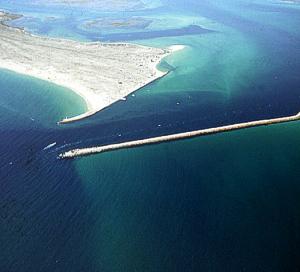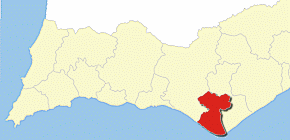|
Tourism |
|
| Portugal > Tourism > Algarve > Faro | |
| History | The Municipality | The City | Lodging | Handicrafts | Gastronomy | Beaches | |
|
|
|
 |
| History |
| The Ria Formosa lagoon attracted human occupants from the Palaeolithic
age until the end of pre-history. During that time a settlement grew
up - Ossonoba - which was an important town during the period of Roman
occupation and, according to historians, the forerunner of present-day
Faro. From the 3rd century onwards and during the Visigothic period
it was the site of an Episcopal see. With the advent of Moorish rule
in the 8th centurh Ossonoba retained its status as the most important
town in the southwest corner of the Iberian Peninsula. In the 9th century
it became the capital of a shortlived princedom and was fortified with
a ring of defensive walls. At this time the name Santa Maria began to
be used instead of Ossonoba. Later on the town was known as Harune,
whence its current name, Faro. After a traumatic period attributable
to the political and military fragility of the town's Moorish rulers,
in 1249 Faro became part of Portuguese territory. thus completing the
Christian reconquest of what is now Portugal. In the centuries that
followed Faro became a prosperous place, thanks to its geographical
position, its safe harbour and growing trade - in salt and agricultural
products from the interior of the Algarve - increased by the voyages
of exploration known as the Discoveries. At this time the town had a
large and active Jewish population: the first Portuguese book was printed
locally on the Jewish community's initiative at the end of the 15th
century. Recognising the town's growth, in 1499 King Manuel set in motion
major changes to the urban. fabric, with the construction of new facilities
- a hospital, the Espirito Santo (Holy Spirit) church (later rebuilt
and run by the "Misericordia" (charity and welfare institution),
a customs house, a slaughterhouse and so on, outside the city walls
and along the coast. In 1540 Faro was elevated to the status of a city
and in 1577 it became the site of the Episcopal see of the Bishop of
the Algarve, who had previously had his throne in Silves. In 1596 it
suffered a severe mauling at the hands of raiding soldiers led by the
Earl of Essex, Essex's men sacked the city, then set it alight, damaging
its fortifi'catious and its churches. The 17th and 18th centuries were
a period of expansion for Faro. A new series of battlements was built
during the Wars of Restoration (1640-1668), enclosing the urban area
and tracts of arable land in a huge semi-circle facing the Ria. The
city remained within these confines until the end of the 19th century.
After years of steady but unspectacular growth, its expansion has accelerated
significantly in the last few decades. Its elevation to the status of a city, in 1540, and the transfer. in 1577, of the Episcopal see which had until that point been located in Silves, were important steps in Faro's history. Its steady, growth and its importance in the regional context were such that it was chosen as capital of the Algarve province at the time of the administrative reorganisation which took place in the 19th century. The last few decades have made a decisive contribution to Faro's position, injecting new economic life and confirming its vocation as a service centre for the whole of the Algarve. The construction of an international airport on the outskirts of the city in 1965 made Faro a hub for tourist traffic across the region. Other items of infrastructure uvhich have had a positive impact on the economic, social and cultural life of the city are the University of the Algarve and the Conservatorio Regional (Music Regional College), both of which have their headquarters in Faro and attract students from the rest of the region and from other parts of Portugal, and the district hospital. With its rich artistic heritage and many museums, hotels, restaurants and other facilities, not to mention the many attractions offered by the surrounding area, from the long beaches of Faro, Farol and Culatra Islands to the important Roman ruins at Milreu, Faro is also a city, with a strong vocation for tourism. |
| History | The Municipality | The City | Lodging | Handicrafts | Gastronomy | Beaches | |
| Portugal > Tourism > Algarve > Faro | |
|
Faro |
|
